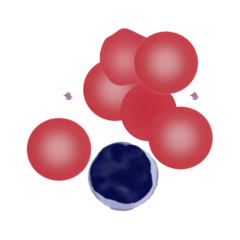Understanding red cell morphology - a short guide: Difference between revisions
From haematologyetc.co.uk
(Created page with "NOTE Use existing red cell biconcave disk, with the following accompanying text: The function of red cell is to safely transport haemoglobin between lungs and tissues. This function requires the different elements of red cell structure to work together. Each of these elements may be affected by inherited or acquired disease - each in turn can cause abnormal morphological appearances. NOTE Now we have these pieces of text that ideally act as buttons or have attached butto...") |
No edit summary |
||
| (12 intermediate revisions by the same user not shown) | |||
| Line 1: | Line 1: | ||
---- | |||
1. Red cell formation: The bone marrow generates uniformly sized mature erythrocytes, but the cells can make extra (or fewer) divisions according to physiological or pathological circumstances – | <gallery mode="nolines" widths="240px" heights="240px" border="1px" > | ||
2. Haemoglobin: To collect oxygen in the lungs and gives it up within tissues the four chains of the haemoglobin molecules have a complex interaction – changes to the haemoglobin molecule can affect its solubility or stability leading to characteristic morphological change. | File:RC_C_agglutination_G.png|link={{filepath:RC_C_agglutination_G.png}} | ||
3. Cytoskeleton and membrane: The baseline state of the red cell is a biconcave disk - this allows optimal gas exchange, the cell flexes to form other shapes in fast blood-flow, or when navigating small capillaries. | </gallery> | ||
4. Metabolism | |||
The function of red cell is to safely transport haemoglobin between lungs and tissues. This function requires many different elements of red cell structure and function to work together. The problem is that the cell can do little to compensate if anything goes wrong. The effects of any of these problems can cause typical morphological changes. | |||
Below are descriptions of "normal" and some examples of how things going wrong! | |||
---- | |||
:'''1. Red cell formation''' | |||
:The bone marrow generates uniformly sized mature erythrocytes, but the cells can make extra (or fewer) divisions according to physiological or pathological circumstances, and is also subject to canges caused by systemic illness or malignant change – any of these may affect red cell size or uniformity. | |||
::[[Red cell formation and disease|Click for more about red cell formation and disease]] | |||
---- | |||
:'''2. Haemoglobin''' | |||
:To collect oxygen in the lungs and gives it up within tissues the four chains of the haemoglobin molecules have a complex interaction – changes to the haemoglobin molecule can affect its solubility or stability leading to characteristic morphological change. There are a wide range of inherited diseases of haemoglobin that often cause characteristic changes to the appearance of red cells. | |||
::[[Haemoglobin and disease|Click for more about haemoglobin and disease]] | |||
---- | |||
: '''3. Cytoskeleton and membrane''' | |||
:The baseline state of the red cell is a biconcave disk - this allows optimal gas exchange, the cell flexes to form other shapes in fast blood-flow, or when navigating small capillaries. Inherited changes or damage to cytoskeleton or membrane can significantly affect shape. | |||
::[[Cytoskeleton, membrane and disease|Click for more about Cytoskeleton, membrane and disease]] | |||
---- | |||
: '''4. Metabolism''' | |||
The red cell has no mitochondria, so has limited power to generate or protection from oxidative damage. In conditions of cell stress or enzyme deficiency the limited metabolism the red cell makes it vulnerable to damage that often produces characteristic forms. | |||
::[[Red cell metabolism and disease|Click for more about red cell metabolism and disease]] | |||
---- | |||
Latest revision as of 15:43, 1 March 2023
The function of red cell is to safely transport haemoglobin between lungs and tissues. This function requires many different elements of red cell structure and function to work together. The problem is that the cell can do little to compensate if anything goes wrong. The effects of any of these problems can cause typical morphological changes.
Below are descriptions of "normal" and some examples of how things going wrong!
- 1. Red cell formation
- The bone marrow generates uniformly sized mature erythrocytes, but the cells can make extra (or fewer) divisions according to physiological or pathological circumstances, and is also subject to canges caused by systemic illness or malignant change – any of these may affect red cell size or uniformity.
- 2. Haemoglobin
- To collect oxygen in the lungs and gives it up within tissues the four chains of the haemoglobin molecules have a complex interaction – changes to the haemoglobin molecule can affect its solubility or stability leading to characteristic morphological change. There are a wide range of inherited diseases of haemoglobin that often cause characteristic changes to the appearance of red cells.
- 3. Cytoskeleton and membrane
- The baseline state of the red cell is a biconcave disk - this allows optimal gas exchange, the cell flexes to form other shapes in fast blood-flow, or when navigating small capillaries. Inherited changes or damage to cytoskeleton or membrane can significantly affect shape.
- 4. Metabolism
The red cell has no mitochondria, so has limited power to generate or protection from oxidative damage. In conditions of cell stress or enzyme deficiency the limited metabolism the red cell makes it vulnerable to damage that often produces characteristic forms.
